We are back with a post on a topic we haven’t covered in depth before. With thanks to our always outstanding contributing writer Brooke Nurthen, here is a look at one of the Duchess’ favorite prints.
Instantly, unmistakably Scottish, tartan has long been a staple for Kate, whose deft touch with sartorial diplomacy and appreciation of the power of symbolism has led to a vast and wonderful display of tartans over the years.
While not showcasing head-to-toe print, as a respectful gesture and nod to her hosts, Kate has sometimes taken to carrying a tartan scarf with her clutch. Below left, Kate (known as the Countess of Strathearn while in Scotland) carries a Strathearn Tartan scarf from Scotweb for the river pageant celebrating the Queen’s Diamond Jubilee in 2012. Centre and right, Kate carries a Maple Leaf Tartan scarf on tour in Canada in 2016.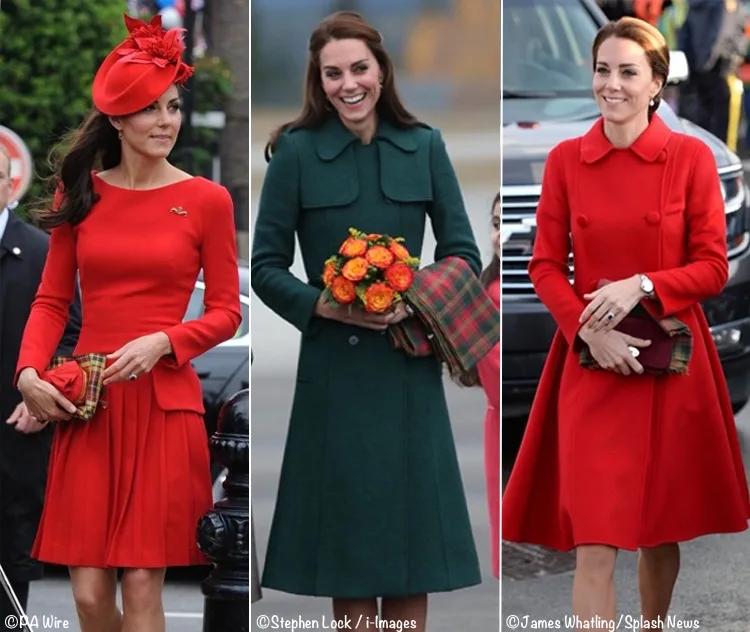
The Duchess sported a navy and grey wool tartan coat by Moloh when visiting Scotland in April 2013. The next day the Countess of Strathearn carried her scarf again, pairing it with her red Armani coat. On Christmas Day that same year, we spotted the Duchess in a Tartan wrap by Really Wild.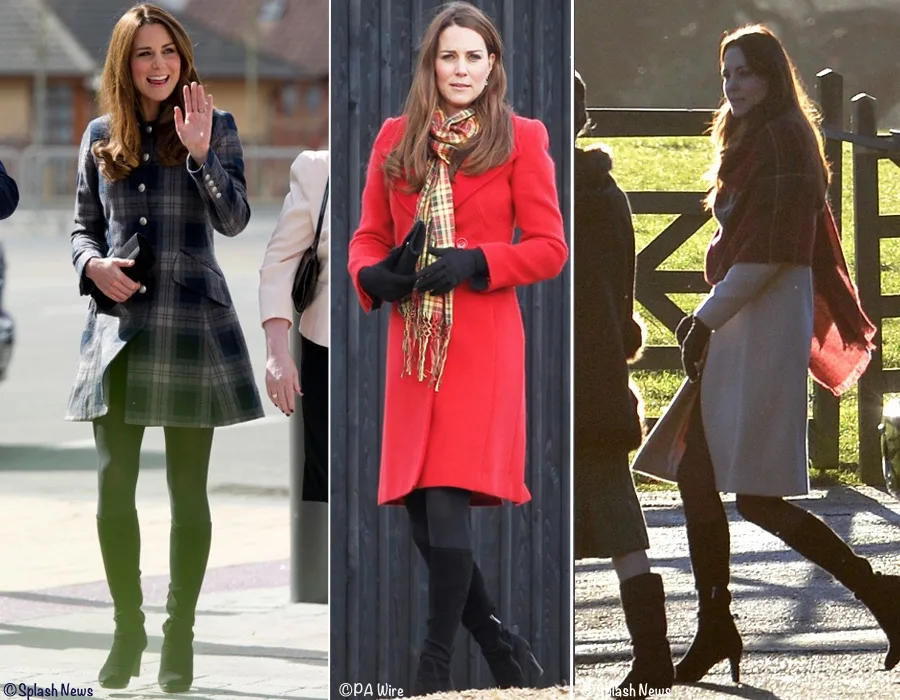
But the preeminent tartan look for most Kate style watchers was seen later that Christmas Day when the Duchess brought back an Alexander McQueen piece (below left). The Black Watch tartan coat dress was first worn in November 2012; the pinnacle of sartorial diplomacy. Worn on Saint Andrew’s Day (Scotland’s national day) to Saint Andrew’s School (the Duchess’ former prep school), the flattering navy and green tartan represents and derives its name from Scotland’s 3rd Battalion Regiment, known as the Black Watch.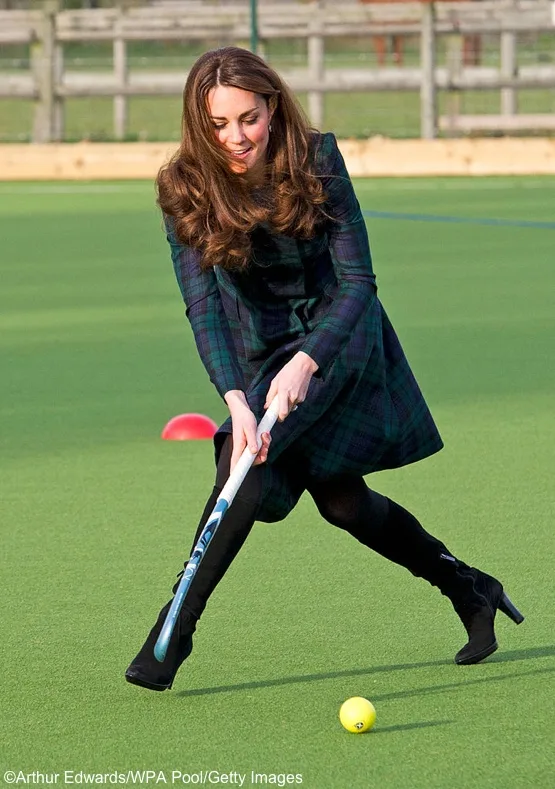
Some information on Black Watch, and the use of tartans, from the Scottish Tartans Authority:
Tradition has it that those who have no tartan of their own can wear the Black Watch (The Universal or Government Tartan) or the Hunting Stewart, but not the Royal Stewart without the express authority of the Queen. However, commercialisation in recent times has rather blurred this. The one tartan which cannot be worn by anyone unless the Queen’s permission has been granted is the Balmoral.
And from the weavers responsible for Kate’s Strathearn tartan scarf, DC Dalgliesh:
The Royal association with tartan really began with the 1822 visit of King George IV to Scotland – the first visit of a reigning monarch to Scotland in nearly two centuries. The famous writer Sir Walter Scott organised the visit, and convinced the King to wear a tartan kilt, which had until recently been banned under the Dress Act of 1746 as a symbol of Scottish rebellion.
Queen Victoria’s husband, Prince Albert, helped to design the Balmoral tartan, which is still regularly worn by the Royals to this day. By convention, no one outside the Royal Family (other than the Queen’s personal piper) may wear the Balmoral tartan. So DC Dalgliesh is one of the few weavers ever to have produced the plaid.
The Balmoral grey, black, white and red is intended to symbolize the rough granite of the Scottish highlands. Below, a look at the fabric as shown at DC Dalgliesh. 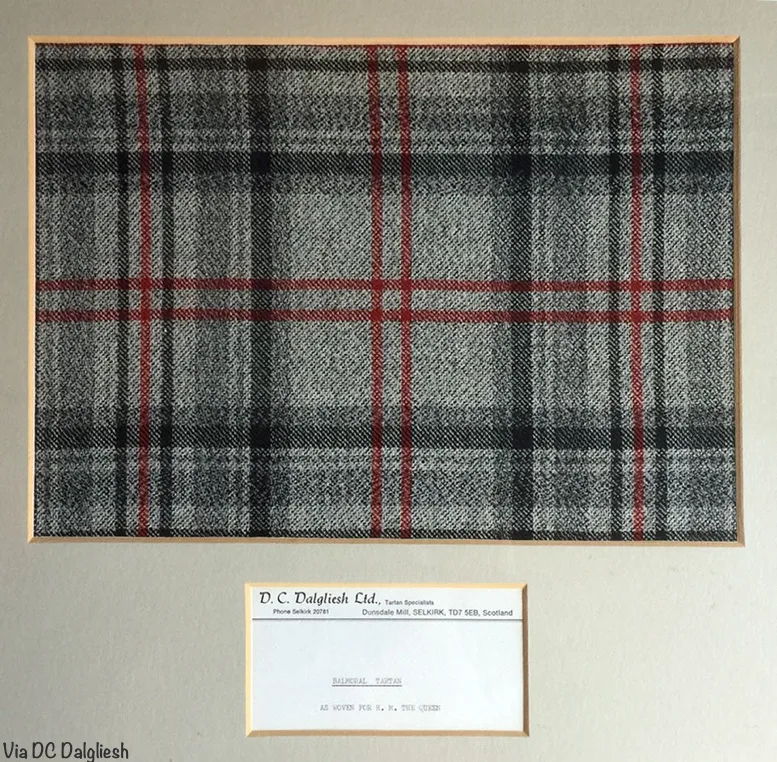
Here you see HM wearing the tartan at Balmoral in 2014. That is Australia’s Governor-General, Sir Peter Cosgrove, that you see in the photo.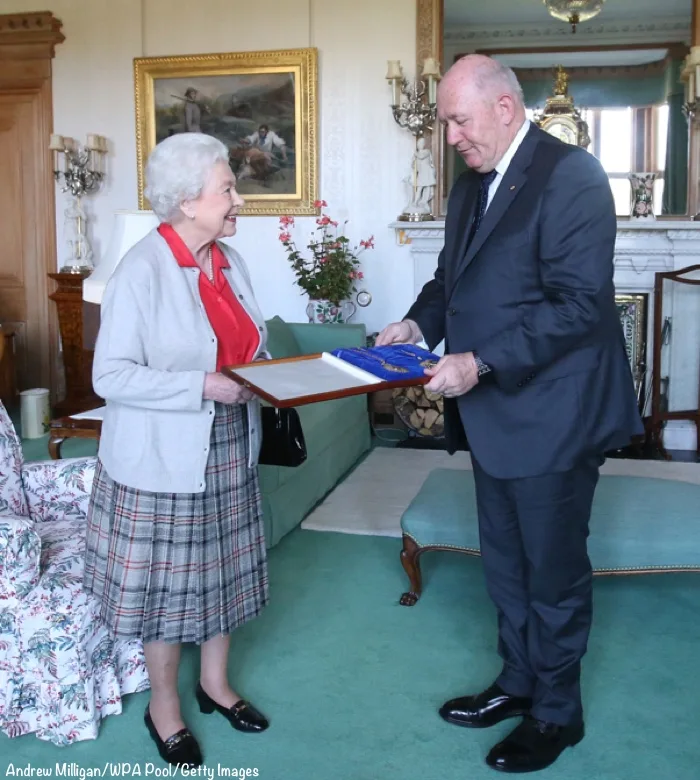
Tartans were originally specific to a place in Scotland, colored with natural dyes available in that location. Clan, or family-specific tartans did not come into their own until the mid-nineteenth century.
While tartan shopping, you may come across distinctions between ‘ancient,’ ‘modern’ and ‘muted’ versions of the same print. These refer only to colour – ancient being lighter, modern is bright and made using chemical dyes, and muted is a shade in between the two. Only in recent years have the colors of tartans come to have meanings in themselves – for example, Kate’s Canadian Maple Leaf scarf, with muted, typically Canadian autumnal tones, is a print developed in the 1950s along with other Canadian provincial tartans.
Currently, there are thousands upon thousands of registered tartans, no longer just for clans and families but for companies, hotels, sports teams and schools. As for the distinction between Tartan and Plaid – in a tartan the horizontal and vertical stripes are identical, while in a plaid they may vary. The latter name is often used in North America, but the two names are now largely interchangeable. 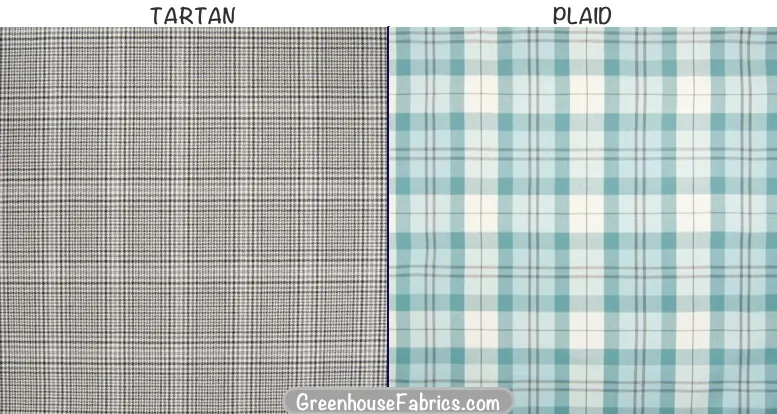
More from Greenhouse Fabrics:
Today, the term Plaid refers to patterns inspired by traditional tartan designs, and the term tartan now refers to a type of plaid. “Plaid” replaced “tartan” once patterns became popular with British and American textile manufacturers who would recreate fabrics inspired by authentic tartans.
UPDATE: More on the distinction between tartan and plaid comes via a comment from Marjorie. She shared that “Tartan is the woven, geometrical design accepted by various clans. A plaid is a garment, the shawl commonly worn by Scottish women, though now seen worldwide.”
For those after a true repli-Kate, the Duchess’s Maple Leaf Tartan scarves are still available at York Shawls and at Scotweb respectively.
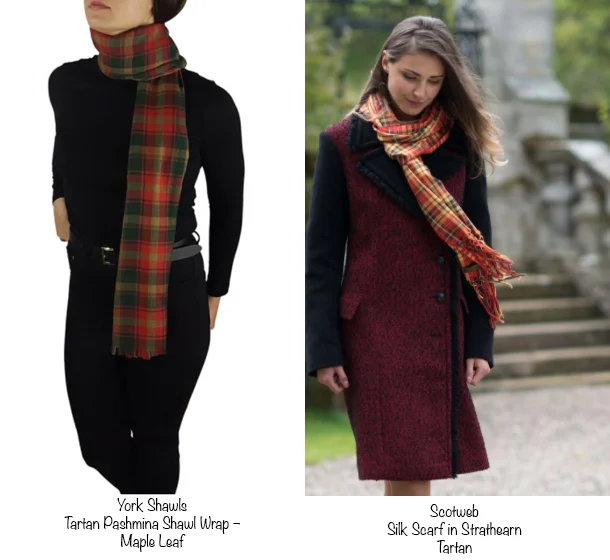
A good stand-in for the McQueen coat, Scotland Shop offers the ‘Kate Coat’ in Black Watch tartan made to measure and available in 519 (yes, five hundred and nineteen) different tartans for your choosing. For those after a smaller hint of the pattern, the Fine Wool Tartan Stole offers a lighter touch of print.
Kate-favoured outerwear brand Barbour, a staple brand of the British ‘town and country’ upper crust, features tartan prints and linings on a majority of garments, including the Classic Beadnell Jacket and Tartan Betty Gilet, both shown at Orvis.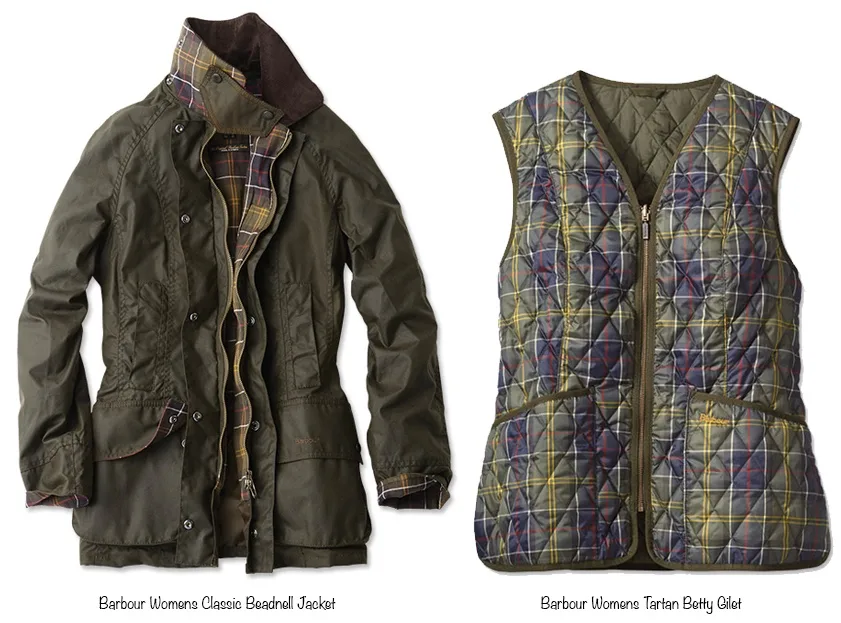
The Princess Diana Tartan childrenswear items from Seraphine, which we reported on back in December 2015, are still available in soft woolens and cotton. The two colorways, one blue and one pink based, are available in a number of boys and girls styles. Left to right, the Blue Tartan Cotton Baby Dress, the Pink Tartan Cotton Baby Dress, and Blue Trim Cotton Baby Grow.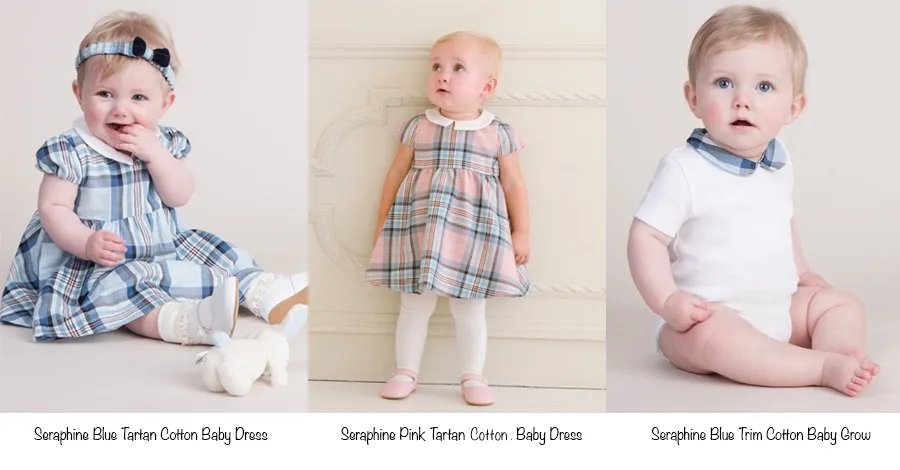
The tartan itself is by Loch Carron, who offer several ladieswear items in the tartans. Below, the rose-tone and pale blue prints – an Extra Fine Merino Stole in the rose, Lambswool Serape and Lambswool Scarf in the blue.
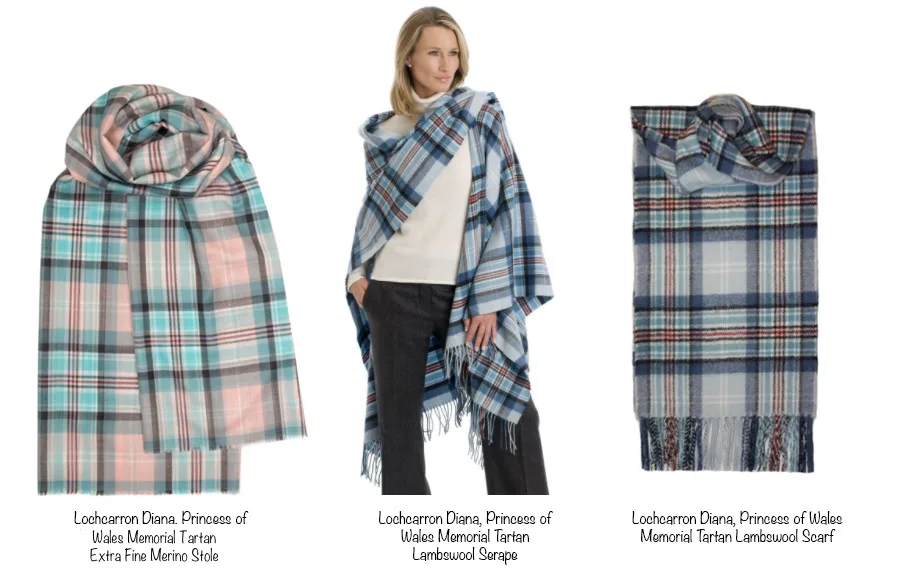
One final look via two photos from Kate and William’s 2014 visit to Scotland (original post is here). You can just see the tartan on the little lamb (I think that’s what it is….?) and then the kilt on the bigger bear.
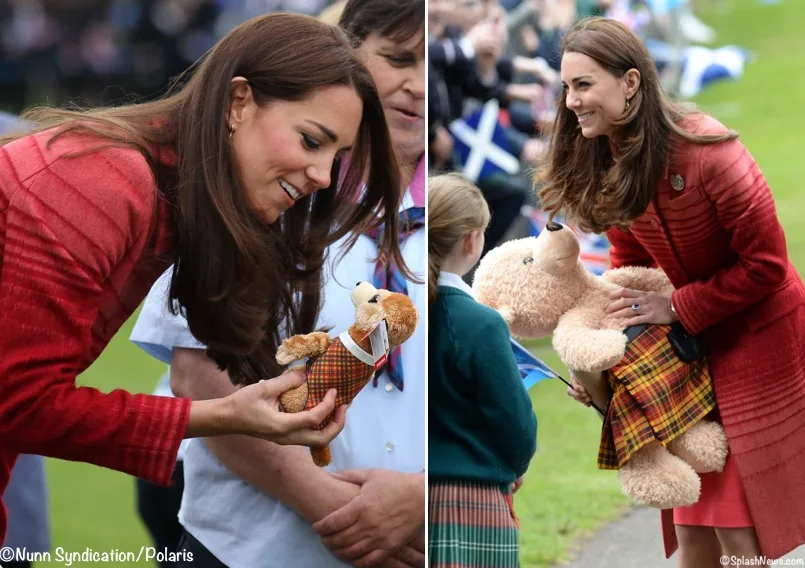
Thank you, Brooke, for a terrific backgrounder on one of my favorite things! You may recall that Brooke has authored other posts here (including this one on tailoring terms), and quite a few for What Kate’s Kids Wore. Speaking of favorite things, another one of mine is the Instagram that Brooke runs with another friend, Rachael. Aptly dubbed Cambridge Mums, the photos showcase Brooke and Rachael and some repliKates.
We also see Brooke’s darling son, Hugo, along with Rachael’s precious Louie.
They are beyond cute, and pictures of them are certain to brighten your day.
++++++++++++++++++++++++++++++++++++++++++
Our final item involves a bit of housekeeping. I want to thank everyone who shared their thoughts about the two book giveaways. It is clear from some of the comments on the most recent post that giveaways are not popular, at least not with a significant number of readers. We have generally limited ourselves to 2 such events a year plus our annual WKW Calendar giveaway. It happened that the 2 for this year were back to back because of the publication dates for the books. My inclination is to cease doing them altogether with the exception of our annual WKW calendar giveaway. But to be sure I’m not misreading the comments, doing a poll seems like a good way to get everyone’s feedback.
One other note in response to a comment suggesting the giveaways are done as a means of generating revenue, that is not the case. (If anything, sometimes they cost money; not all sponsors will ship internationally, so sometimes we have picked that up ourselves.) I’m not complaining, to the contrary – I am happy to do the work because they have been fun. But if it turns out they no longer have appeal for the majority of readers it doesn’t make sense to continue doing them. A ‘thank you’ in advance for voting and letting me know what direction to take in the future!
[polldaddy poll=9858223]

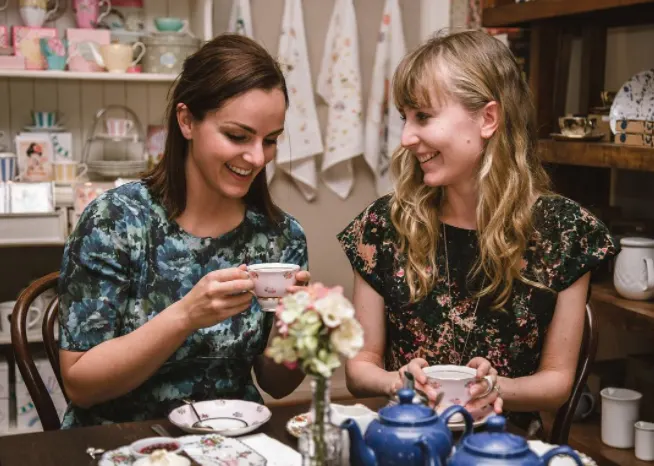


Douglas Campbell
Thursday 26th of July 2018
There is a common misconception about the Black Watch tartan.
Some people believe that it was originally a clan tartan that was adopted by members of the Black Watch, while others believe it was originally a military tartan that Campbell clan members began to wear.
In “Campbell Tartan”, there is an entry in the publication stating that there were six different companies in 1725, and they all wore a standardized tartan. From the six, three of these companies were Campbell’s, and it appeared that the sett they wore was adopted by other members of the Black Watch. There is an interesting history to the Black Watch tartan - https://www.kilts.com/black-watch-kilt/.
Jessica
Monday 30th of October 2017
Terrific post. That red McQueen for the Jubilee river pageant is one of my all-time favorite looks on the Duchess.
I really feel like I need a tartan wrap for the holidays now. :)
Jess
Saturday 28th of October 2017
As a Scot, I appreciate people wearing tartan and loving our heritage as much as we do. My little request is please don't wear kilts if you aren't from here and don't know why they mean so much to our culture.
Bonnie
Sunday 29th of October 2017
Jess, would you please elaborate as to why only Scottish people should wear kilts. Where I live in Canada, every secondary school, that has a uniform, has the girls in kilts. The tartan is always in the school colours and it is standard dress. I own three kilts, all purchased on trips to Scotland. Surely the stores would not be selling them to non Scots, if it was offensive for the purchasers to wear them. In fact, I think it would be a nod to your heritage to have others show interest in wearing a kilt. Never did I see this as disrespectful.
Cathie
Friday 27th of October 2017
I really enjoyed this post, as I love tartan and plaid!
I would have entered the second contest, but didn’t want to be greedy as I’d just won the other one. However, I do wish I had entered now, to at least boost the engagement! I love any and all giveaways, and never say no. :) Thank you so much for all that you do.
LadyLeah
Saturday 28th of October 2017
Congrats to you!
Anne-Christine
Friday 27th of October 2017
I think Catherine looks terrific in her tartans. It's a time-honored style, but it doesn't look staid on her. I have to admit, I bought the York Maple Leaf tartan scarf, and I love to wear it. Now I'm yearning for the affordable wool Strathearn (not the silk-- sigh-- too much of a splurge). It's that time of year! Re: Catherine carrying her scarves: she may like just the pop of color. However, she also knows that it's there if she's feeling chilly!